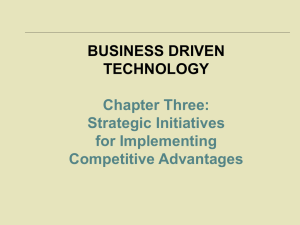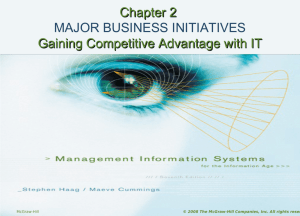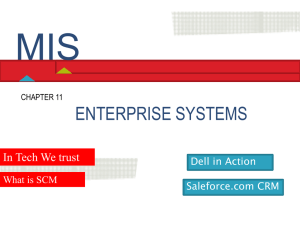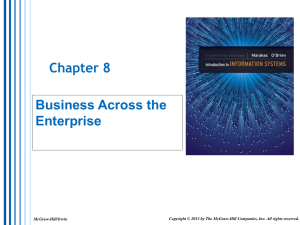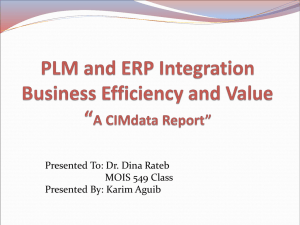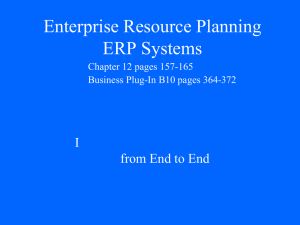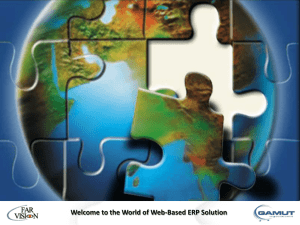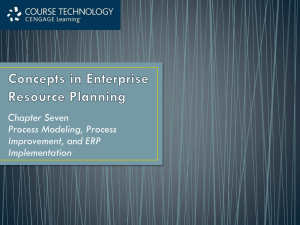TOC 2
advertisement
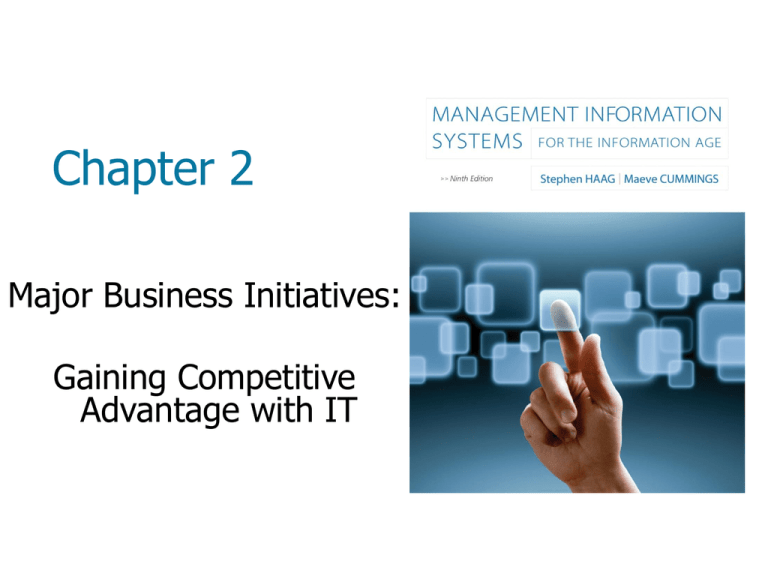
Chapter 2 Major Business Initiatives: Gaining Competitive Advantage with IT STUDENT LEARNING OUTCOMES 1. Define supply chain management (SCM) systems and describe their strategic and competitive opportunities. 2. Define customer relationship management (CRM) systems and describe their strategic and competitive opportunities. STUDENT LEARNING OUTCOMES 3. Explain the significance of enterprise resource planning (ERP) software as the integration of functional software systems. 4. Define social media and describe a few of its many dimensions that make it important in the business world. DEATH OF THE TRAVEL AGENT DEATH OF THE TRAVEL AGENT • Chart shows the impact of technology on the number of travel agents in the U.S. • Consumers are now “empowered,” number of travel agents has declined from 171,600 (1999) to 95,000 (2009) Questions 1. When you last flew, did you use a travel agent or directly to the Web for tickets? 2. What is your preferred travel site? What features do you like? 3. Why do airlines support moving reservation systems to the Web? SUPPLY CHAIN MANAGEMENT • Supply chain management (SCM) – tracks inventory and information among business processes and across companies (suppliers) • Supply chain management (SCM) system – IT system that supports supply chain management • Just-in-time (JIT) – method for producing or delivering a product or service just at the time the customer wants it Dell’s Effective SCM Through JIT Supply Chain Management • Most supply chains use inter-modal transportation, multiple transportation channels (railway, truck, etc) to move products from origin destination • This creates supply chain complexities Opportunities of SCM • Business strategy – Overall cost leadership – Running the organization (RGT) framework • Goal is to reduce costs throughout the supply chain • Optimize fulfillment, logistics, production, revenue and profit, and cost and price IT Support for SCM • SCM systems pioneered by specialist companies • SCM is now part of ERP software (discussed later) • Learn more – – – – MicroSoft Dynamics GP Demo NetSuite Procure-to-Pay Demo IBM Sterling SCM Systems CIO Magazine CUSTOMER RELATIONSHIP MANAGEMENT • Customer relationship management (CRM) system – uses information about customers to gain insight into their needs, wants, and behaviors in order to serve them better • Includes multi-channel service delivery, multiple ways in which customers can interact with a business The Focuses of Customer Relationship Management Analytics is now a huge part of CRM. Analytics use hard data to support decision making. Customer Relationship Management • Sales force automation (SFA) systems – automatically track all the steps in the sales process – – – – – Sales lead generation and tracking Listing potential customers Market and customer analysis Product configuration Getting repeat customers GM’s Sales Force Automation (Purchase Funnel) Opportunities of CRM • Business strategy – Differentiation and focus – Growing the organization • Classic goals – – – – Treating customers better Understanding their needs and wants Tailoring offerings Providing “delightful” experiences IT Support for CRM • Front-office systems – primary interface to customers and sales channels • Back-office systems – fulfill and support customer orders • Both interface to CRM database and analysis and reporting systems IT Support for CRM IT Support for CRM • Software-as-a-service (SaaS) – software model in which you pay for software on a pay-per-use basis instead of buying the software • Learn more – – – – Salesforce.com CIO Magazine CRM Today destinationCRM.com ENTERPRISE RESOURCE PLANNING • How do you bring together SCM, CRM, and other systems? With an ERP system. • Enterprise resource planning (ERP) system – collection of integrated software for business management, accounting, finance, supply chain management, inventory management, customer relationship management, e-collaboration, etc. ENTERPRISE RESOURCE PLANNING • ERP is big business • Federal government will spend $7.7 billion on ERP in 2009 • 60% of Fortune 1000 companies have ERP systems ENTERPRISE RESOURCE PLANNING The Big 4 ERP Vendors ERP Evolution • MRP – 1970s; focus on production planning, calculating time requirements, procurement; basic automated manufacturing focus • MRP II – 1980s; closed the loop to include financial and accounting systems and serve as a decision support tool for managers ERP Evolution • ERP – late 1980s/early 1990s; focus on critical “time to market”; shorter lead times; customers want it now • ERP II – today; focus on complete ERP integration with CRM, business intelligence, and a host of other applications across the organization ERP Functionality ERP • Attempts to integrate everything – – – • CRM drives what SCM will produce Everyone works together in e-collaboration The entire organization knows the entire organization Think about your school – – Can you register for class with a bill outstanding? Can you register for a class for which you haven’t completed the prerequisite? ERP Integrates Everything ERP and Market Size • Many ERP vendors based on organization size • Small business – less than 100 seats • Medium-size business – 100-500 seats • Large business – more than 500 seats ERP Demo • Total ERP SOCIAL MEDIA • Social media – Web-based and mobile technologies that create interactivity among users • Web 2.0 – second generation of the Web focusing on – online collaboration – users as both creators and modifiers of content – dynamic and customized information feeds – and many more engaging technologies The Evolution of the Web Some Aspects of Social Media • • • • • • Social networking Social shopping Social playing Social “saving the world” Social locationing There are many more Social Networking • Social networking site – site on which you post information about yourself, create a network of friends, read about other people, share content, and communicate with people • The big ones – Facebook & LinkedIn – Google+ – StumbleUpon, Twitter, YouTube Social Networking Players Social Shopping • See what other people are buying and wearing, trying to find the same, and informing others of where the best deals are • Pepsi – social vending machines • Bartab • Groupon Social Playing • MMORPGs (massively multiplayer online role-playing games) – thousands or millions of people play and interact in a virtual world Social Playing Social Playing • World of Warcraft – Largest, 11 million players – Complete quests in a world of monsters, uber-warriors, and mythical creatures • Second Life – Virtual world – Avatar – Linden dollars Social Playing • Zynga – Over 270 million play Zynga games on Facebook – Cityville – Farmville – Mafia Wars – Zynga Pokerr – Words with Friends Social “Saving the World” • Games that support sustainability and triple-bottom-line efforts Social “Saving the World” • Pepsi Refresh Project – education, arts and music, communities • Toyota Ideas for Good – use Toyota technology for non-auto uses • Volkswagen Fun Theory – change behavior of people for the good • TOMS One-for-One – buy shoes and have a free pair donated to someone Social Locationing • Social locationing (location-based services) – use of a mobile device and its location to – Check into locations – Find friends and their locations – Receive rewards – Take advantage of specials based on location Popular Social Locationing Systems • • • • • • Geoloqi Facebook Places SCVNGR Google Latitude Foursquare Gowalla


